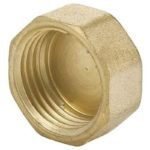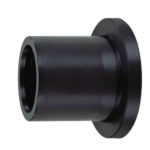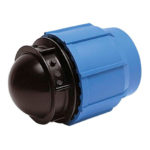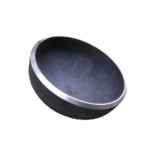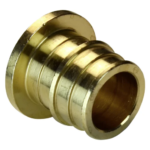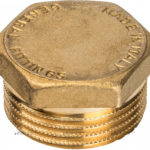To prevent possible water leakage during the repair of a section of communication, a threaded plug is placed on the water pipe. This type of sealing is the simplest.
Purpose and principle of operation
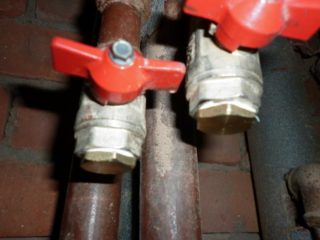
A plug is called a special fitting, with which you can shut off the water supply in the system at a certain section of it. The element has the shape of a circle or square. The latter are rarely used for plumbing.
The plug is used for the following purposes and in the following situations:
- Protection of the inner part of the pipe from moisture and dirt, penetration of rodents, insects. This option is observed when installing fence posts from round / square tubes.
- Jamming a plastic water pipe or a sewer metal / polymer pipe at the time of repair plumbing work in the system (installation / dismantling of its individual elements).
- Protection of tubes from the ends at the time of their transportation.
To plug the gas pipeline, special flange plugs are used. They are subject to repeated assembly / disassembly.
Any plug works on the principle of complete sealing of the pipe opening. It is a kind of cork. If it is necessary to lengthen the system (sewer, gas or water supply), the plug is simply removed from its place.
Types of plugs
All fittings used for damping pipes are classified according to the material of manufacture, the method of installation and the type of construction. Products are made from the following materials:
- Metal (brass, steel, cast iron). Fittings have a high tensile strength, therefore they are widely used in public highways (gas and water supply, sewage). However, metal plugs are susceptible to corrosion. Chrome plated steel fittings are an exception. This material will not rust. Metal fittings also include a special plug for sealing. It has a special technical hole for the installation of a seal. As a result, it will be impossible for third parties to interfere with the system.
- Polymers. Plastic plugs are widely used in private construction. The material does not rust or wear out. Polymer fittings are deformed under the influence of high temperatures (sun, hot water from +85 degrees). Polyethylene fittings are used for the inner pipe plug.
- Rubber. The simplest type of element, used either for decorative purposes or exclusively in a private plumbing.
By design, muffling fittings are divided into the following types:
- Threaded. The simplest of all stubs. Simply screwed into or onto the pipe.
- Flanged. It is assumed that there are technical holes along the edge, into which the fastening bolts are driven. The flange plug is more often attached to the casing or gas pipe using reinforced hardware (nuts / bolts). If necessary, the fitting can be dismantled at the right time. As a rule, the flange element is made of metal.
- Pneumatic. Made of rubber. You can install such an element using a pump by injecting air into it. The fitting has a special fitting with a hose. Through it, air is injected and pumped out into the plug and back. Such an element can operate at temperatures from -40 to + 70 degrees. The peculiarity of the pneumatic fitting is that it will hermetically close the lumen of the pipe, regardless of the evenness of its inner walls.
- Elliptical.The installation is carried out using welding.
By the type of installation, all plumbing elements for muffling are divided into two types:
- Internal. They are mounted using special ribbed notches. The top of the fitting is covered with a cover.
- Outdoor. They work simultaneously as a decorative element and as a muffler.
There are types of plugs according to their purpose - end caps and shipping. The first ones jam a section of the system. The latter are used to protect the ends of the pipes during transportation. Their strength characteristics are seriously inferior to those of end caps.
Fitting selection criteria
The plug is chosen according to several parameters:
- Manufacturing material. As a rule, PVC fittings are used for metal-plastic pipes, polyethylene fittings for PET, and steel or brass fittings for metal. Rubber ones are used as temporary ones.
- Diameter, size and shape. Plugs with a cross-section must exactly match the parameters of the communication pipes. In addition, round fittings are used for round elements, and square fittings for profile ones.
- Appointment. For long-term sealing of the pipe, it is better to buy a threaded or elliptical fitting. If the plug is put on for a short time, it is better to take a flange plug. Moreover, it is not recommended to buy rubber and polymer plugs for the hot water system or heating pipes. They change their shape when exposed to high temperatures. As a result, a depressurization of the system may occur. Gas pipelines are not fitted with pneumatic or threaded plugs. It is better to use flanged ones here.
Decorative caps are made from PET of various shades. Color is added to the polymer at the casting stage. The fitting is painted over uniformly and over the entire thickness of the plastic.
Principles and features of mounting different types of plugs
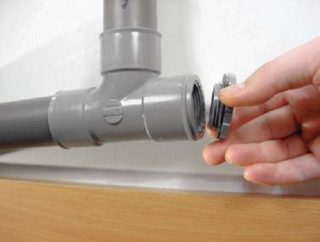
The pipe muffler can be installed in different ways, depending on its design features. The following steps are taken:
- Screwing in. In this way, a threaded fitting is installed. Before installing it, you must use fum tape and sealant. They additionally protect the system from leakage. The tape is wound in a small layer on the outer part of the fitting and screwed on. The screw plug is screwed on by hand until it stops, but without excessive tension.
- Welding. Suitable when installing an elliptical element. It is possible to achieve complete tightness of communication. In this case, only a specialist should carry out the work. The welded plug is placed for a long period and is not suitable if any repair work is expected to be carried out in the near future on the communication section.
- Using bolts and nuts. This method is used to install a flange muffler. Before installation, place a seal between the fitting and the pipe. It, in turn, is selected in accordance with the permissible temperature indicators for a particular system and according to the pressure requirements in it.
- Air injection. The plug for the water supply can be delivered in several stages. Water is removed from the pipe, a hole is made in the desired section of the system, a fitting is inserted and air is injected into it. Expanding, the walls of the plug fit snugly against the inside of the pipe. Remove the pneumatic fitting at the end of the repair work. To do this, you just need to pump out the air from the rubber stopper and remove it.
Thanks to the huge assortment of stop fittings, it is possible to solve the issue of sealing the pipeline and the decorative appearance of profile tubes used as fence posts. It is only important to make the right choice.

